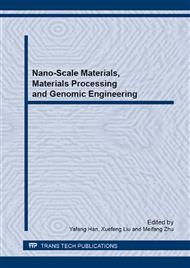p.106
p.112
p.117
p.122
p.130
p.136
p.142
p.148
p.154
Fabrication and Properties of Porous Scaffolds of PLA-PEG Biocomposite for Bone Tissue Engineering
Abstract:
Porous scaffolds of polylactic acid-polyethylene glycol block copolymers (PLA-PEG) biocomposite were fabricated by solvent casting-particulate leaching method using sodium chloride as the porogen. With the aim of evaluating the influence of porosity on mechanical properties and biocompatibility, three specimens of scaffolds which have different porosity (around 50%, 60%, 70%) were fabricated. Murine fibroblast grew cells (L929) were seeded into PLA-PEG porous biocomposite scaffolds. The tetrazolium salt 3-[4, 5-dimethylthiazol-2-yl]-2, 5-diphenyltetrazolium Bromide (MTT), scanning electron microscopy and confocal microscopy were carried out to characterize cell proliferation and morphology. The composite scaffolds with the porosity of 50% possessed better mechanical properties. All scaffolds support attachment, spreading and proliferation of L929, and the biocompatibility of scaffolds could be improved by increasing the porosity. The fabricated PLA-PEG porous biocomposite scaffolds with good mechanical properties and biocompatibility might be used in bone tissue engineering.
Info:
Periodical:
Pages:
130-135
Citation:
Online since:
April 2014
Authors:
Price:
Сopyright:
© 2014 Trans Tech Publications Ltd. All Rights Reserved
Share:
Citation:


